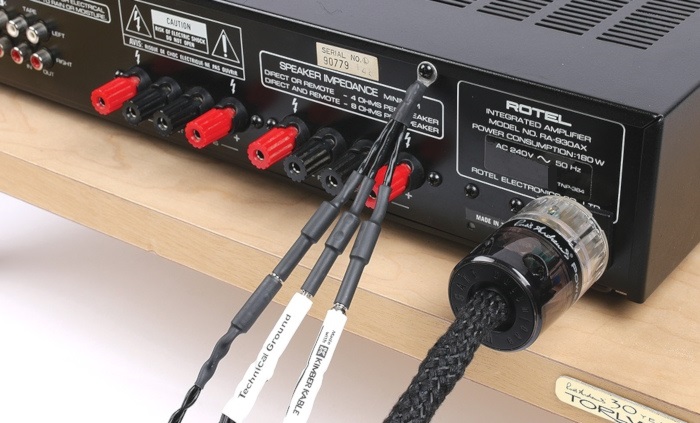Understanding the Grounding System
Click here to open a printable pdf of this article
What's the difference between Earthing and Grounding?
(If you simply want to know how to set up your grounding system, skip to Section 2, here)
It is crucial in any guide to improving your grounding that a clear distinction is made between grounding and earthing. The two are often confused and it helps to understand what each does.
Earthing
Earthing is the term we use to talk about a connection that involves the electrical safety wiring in a mains powered house supply installation (230V AC here in the UK), or mains powered equipment. It is the wire that provides the safe path to ground of a fault current, preventing electrocution in the event of a live fault making contact with exposed metal parts.
In other words, if a fault occurs within a component causing a live part of the internal circuit to touch the external casework, the earth wire safely carries this current away from the component to ground. In theory, you shouldn’t get a shock (or worse) when you touch the casework in the event of a fault.
The earth wire is a yellow/green cable of sufficient size to carry the likely fault current. It requires a low resistance, direct path to ground; the final connection to earth somewhere outside your house, usually provided by your electricity supply company.
Not all mains powered HiFi equipment has this connection to earth, however; more about this later.
Earthing is for safety!

Earthed equipment should always be connected to your earthed ring main (I will discuss the quality of that earth some other time!).
Grounding
Grounding is the term we use to talk about providing an efficient path to ‘drain away’ degrading RFI (Radio Frequency Interference) signals picked up by the various exposed metal parts of your Hi-Fi system.
These connections are not safety related and are best connected with wires which you fit between the casework - or spare signal sockets in some cases - and our RF Router or SuperRouters, which are specifically tuned to these high frequency signals. The output of the Router is then connected via a low resistance and low inductance cable to a grounding spike. Alternatively, you can use the ground terminal on one of our dedicated wall sockets, or our plug-in RF Router, which provides a path to ground via your normal mains earth.
I have known for very many years that system grounding has a beneficial effect on dynamic range and bass depth, and we have fitted grounding terminals on our Signature PowerBlocks and wall sockets for much of that time.
Why Ground the casework?
So why do we recommend grounding the metal equipment casework?
It’s important to understand how the music signal passing through the circuits in your source components and amplifiers relate to the metal equipment casework that surrounds them.
In a single-ended system (i.e. one where the connections are made with RCA (phono) interconnects), a minimum of two wires is required, one for the music signal and one for the ground: both are needed for the signal to flow as a circuit. The outer part of the phono plug is the ground connection and the centre pin is for the signal.

Image shows grounding cables connected to the chassis of a Rotel amp via a 3-way Chassis Ground Banana Adaptor.
Now, this signal ground is usually (but not always) connected inside equipment to an earth point… an earth point that is also connected to the mains earth and the equipment casework.
If you have a balanced circuit (with XLRs connectors), the signal itself is split into positive and negative but the third pin is essentially the same as the signal ground in single ended circuit. Like that circuit, the signal ground is connected via the earth point to the equipment casework.
You can now see that the equipment casework is linked to the signal ground: therefore, any high frequency RF noise in the signal ground also appears in the casework. Because the casework is linked to the signal ground, this also means it’s relatively easy to connect the signal ground (via the casework and Router) and dump the noise in it to earth
Why grounding is especially important now
Dumping RFI out of your system has never been more important than now. The RFI fog we endure in the name of 'staying connected' is a serious issue for the Hi-Fi enthusiast, and it can only get exponentially worse into the future.
As we progress through 3G, 4G and into 5G, the mast density in the environment increases and the broadcast power and frequencies go up to achieve the area coverage and data density we all demand. We now expect super-fast broadband speeds. Emergency Services are ramping up their communication networks to give Police, Ambulance and Fire Service personnel better live voice and video computer-driven control.
You may be sensibly not using Ethernet-over-mains devices (see John Armer's article about this here), but your neighbours probably are because they don't want to use cables to connect all their audio/visual kit. Our need to protect our musical enjoyment from the degrading effects of 21st century lifestyle is urgent and increasingly important. Rest assured; we will continue to work increasingly hard to find effective solutions for us all!
When to Introduce Grounding
We have found the effects of grounding to be so great, on all levels of system, that we have pushed Grounding up the hierarchy of our Upgrade Steps right to the top alongside the other mains upgrades. It also prompted a reassessment of mains cable earthing itself.
Grounding and cables
Starting with our woven mains cables, our research into Grounding led us to completely redesign their construction. In the light of RFI Grounding issues, we realised that there was an improvement to be gained by stopping the cable weave inducing RFI noise into the earth wire: many prototypes, listening tests and RFI measurements later we launched our Evolution PowerKord range that takes performance to new levels of musicality, resolution and clarity.
The very latest iteration of these cables - the EVO-S - takes the principle to the next level, integrating the mains cable with our Grounding System via connection to the SuperRouters.
We have also looked at the wires and cables we use to implement the grounding process itself, finding that the wire’s geometry and material quality was clearly audible. The improvements brought by using KIMBER KABLE turned out to be just as audible as when they are used as signal or speaker cables!
Click here for Section 2: How to set up your Russ Andrews Grounding System.
Click here to view all grounding products























